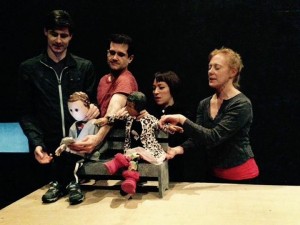 You may know Tera Buerkle from her improv work around town, but in Inside I, she becomes a puppeteer. Find out below why Tera wanted to be a part of Inside I, who her character is, and why she thinks this play might change your life for the better:
You may know Tera Buerkle from her improv work around town, but in Inside I, she becomes a puppeteer. Find out below why Tera wanted to be a part of Inside I, who her character is, and why she thinks this play might change your life for the better:
Q. Inside I uses multimedia techniques to help the audience understand autism. What was your perception of autism before working on this production? And how has this production changed that perception?
A. I had a very limited understanding of autism before working on this show and am grateful for what I’ve learned. The evolution of doctors’ understanding and care for people with autism is fascinating and very easy for me to relate to. In the past, doctors and parents seemed to try to force a person with autism to communicate as neurotypical people do. As someone who dances to her own beat, I very much like the current thinking of accepting people as they are and trying to meet them somewhere in the middle. I learned that meeting one person with autism means that you have only experienced their autism – another person’s will be totally different. Watching interviews with Temple Grandin was fascinating. As a person with autism she explores her thinking and inner life like an artist. We would all be better off if we understood ourselves as well as she understands herself.
Q. Describe your character and their role in the play?
A. My character is Sophia and she grows up with Ben from age 6 to 17 in the play. She is a girl without much guidance that seeks to take care of her wants and needs while being rather unaware of how her actions may affect people. Her interactions with the lead character, Ben, are a sampling of what people with autism, and regular people, may experience from their peers while growing up.
Q. Inside I is told through video, puppetry, and other visual techniques, what is the biggest challenge as an actor in telling a story this way on stage?
A. Michael and Erwin have really set up a story which is shown and not told (my favorite kind of art.) While there is a good deal of technology and blocking in the piece we have to make our performances intimate and relatable to pull audience members in and hopefully stir up empathy. While this is a story primarily about an autistic person I think many people will easily relate to the characters. The themes are similar for many families.
Q. What do you hope audiences will walk away talking about after seeing Inside I?
A. I hope audiences will get a taste of an experience outside of their own. I hope they will relate to the characters and that the play will expand their thinking about people that have different perspectives than their own. I hope it will change everyone’s lives for the better!!!
 You may know Tera Buerkle from her improv work around town, but in Inside I, she becomes a puppeteer. Find out below why Tera wanted to be a part of Inside I, who her character is, and why she thinks this play might change your life for the better:
You may know Tera Buerkle from her improv work around town, but in Inside I, she becomes a puppeteer. Find out below why Tera wanted to be a part of Inside I, who her character is, and why she thinks this play might change your life for the better:




